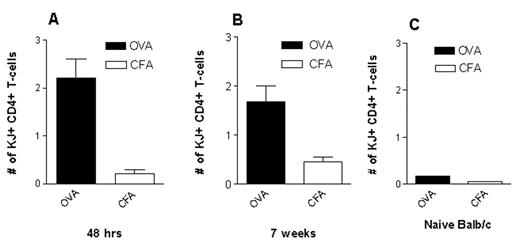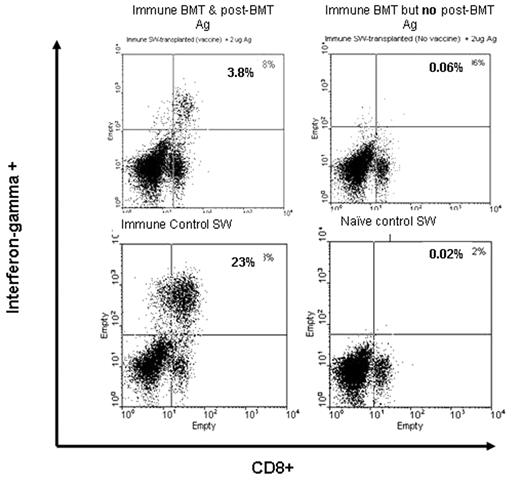Abstract
After transplant the immune system is reconstituted by cells derived from both hematopoietic stem cells and peripheral expansion of differentiated donor T cells. Immune function is poor despite transplantation of mature lymphocytes from immune competent donors. We tested the hypothesis that early antigen encounter at the time of cell transplant would enhance desired donor T cell responses in the post-transplant repertoire. 2 independent models of peptide-specific T cell responses were studied.
Model 1: The model for CD4 cells employed T cells from transgenic DO11.11 mice that constitutively express the T cell receptor for the class II restricted ovalbumin (OVA) peptide 323–339. Fig 1: Early exposure to OVA antigen enhances clonal expansion of OVA specific transgenic T-cells following syngeneic BMT. Lethally irradiated BALB/c mice were injected with 300 μg of OVA peptide in CFA or CFA alone subcutaneously one day before transplantation (D-1). The transplanted mice received 2x106 transgenic OVA specific T-cells and 6x106 non-transgenic naive BALB/c bone marrow cells. At 2 days (A) and 7weeks (B) following BMT, draining lymph nodes were isolated and examined for the presence of OVA-specific T-cells using FITC-labeled KJ-126 antibody and PE-labeled anti mouse CD4 antibody. Naïve BALB/c animals were used as negative controls (C). The absolute number of antigen-specific T-cells was determined by multiplying the total cells recovered with the percentage of OVA-specific CD4+ T-cells identified by flow.
Model 2: The model for CD8 cells employed nontransgenic H2-Db-restricted T cell responses to the influenza nucleoprotein peptide 366–374. Fig 2: Antigen specific CD8+ cells in antigen-exposed animals are functionally active. Donor SW mice were immunized three times by ip injection of virus-infected spleen cells. Recipient C57BL/6 animals underwent BMT using influenza-immune donors spleen cells and bone marrow (10x106 and 4x106 respectively). Some transplant recipients were exposed to influenza virus on D-1. Ten days following BMT, the animals were sacrificed and spleens were isolated and stimulated in vitro with 2 μg of NP peptide. After two rounds of stimulation, the splenocytes were assayed by intracellular cytokine assay for the secretion of IFNg by staining with PE-anti IFNγ and FITC-anti-CD8 antibodies. The results are representative of three experiments (total number n=4/experimental group).
Encounter with specific antigen at the time of T cell transplantation led to clonal expansion of donor T cells and preservation of donor T cell function in the post-transplant immune environment. Antigen-specific donor T cell function was poor if antigen encounter was delayed or omitted. Severe parent>F1 graft versus host reactions blocked the effect of early antigen exposure.
Author notes
Corresponding author



This feature is available to Subscribers Only
Sign In or Create an Account Close Modal